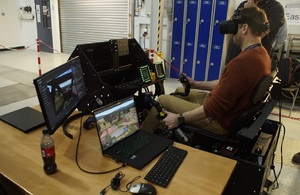Technical take off for UK Armed Forces
A newly developed programme will deliver battlespace solutions to the UK Armed Forces.

The Defence Science and Technology Laboratory (Dstl) has developed an innovative programme aimed at delivering battle winning technologies to the UK Armed Forces’ fleet of aircraft.
The tri-service collaboration is supported by industry partners, the Tactical Aviation Contested, Degraded and Operationally (T-CDO) limiting environments programme, and has been developed to seek battlespace solutions to problems from a range of emerging and evolving threats.
Tomorrow’s tactical environment is a very different place. The development of mega cities has created massive urban landscapes, too large and logistically important to simply bypass.
New threat systems are also coming into play. The rise of the drone in warfare continues, with small Remotely Piloted Air Systems (RPAS) now being available globally, cheaply, and providing unprecedented levels of sensing and strike capabilities to non-state actors.
Principal Engineer for Dstl, Liam Ball said:
The world is becoming an increasingly dangerous place, with new threat actors in the cyber realm rising and growing in confidence and strength. In this environment, the UK must work even harder to ensure its security. To achieve this, the UK must possess and demonstrate the ability to dominate the tactical environment of tomorrow in order to obtain operational advantage in tactical battles.
In its first year of trials, the T-CDO programme has already landed a series of important successes. The four-year project has ambitions of investigating and accelerating novel engineering, logistical and platform solutions from inception to integration.
As an Integrating Capability Challenge, T-CDO has a remit to reach out across all relevant areas of the science and technology (S&T) to help tackle military challenges. The aim is to combat future challenges, such as:
- the increased use of un-crewed and autonomous vehicles
- reducing the risks of tactical surface-to-air missiles and the cyber and electronic warfare capabilities of UK enemies
The programme has designed a proactive and systematic approach to exploiting technological advancements that can deliver the UK and its allies improved operational advantage.
Lt Col Huw Raikes, Army Air Corps, said:
T-CDO is a hugely valuable tool for the Army. Growing from strength to strength, Dstl are employing sophisticated modelling and simulation techniques that assist us in understanding the complex, interconnected and interdependent environment that we will need to operate Aviation within over the next 10 years and beyond. The credibility of the T-CDO output is essential; the Army will rely on it to help guide multi-million pound investment decisions that will shape tomorrow’s fight.
The close liaison with end users and the creation of a ‘problem pack’ that details known challenges and capability gaps for tactical aircraft has received strong endorsement from the Front Line Commands. This will allow situational awareness to sit at the heart of Tactical Aviation CDO’s Aviation Concepts Environment and Common Simulation Environment.
Following further testing the ‘problem pack’ and subsequent breakthrough will be open to input from industry, academia, front line commands and end users by the end of 2023.
The programme’s specialists will be collaborating with an alliance of carefully selected companies, led by Leonardo, to ensure that any solutions taken forward fully address the Tactical Aviation teasers presented in the ‘problem pack’.
Delivering analytical data to assess the suitability of tactical aviation concepts against Land, Maritime and Air domain demands, Tactical Aviation CDO will ensure the UK’s Armed Forces will not be flying blind when it comes to preparing airframes and crews for the future operating environments of 2040 and beyond.